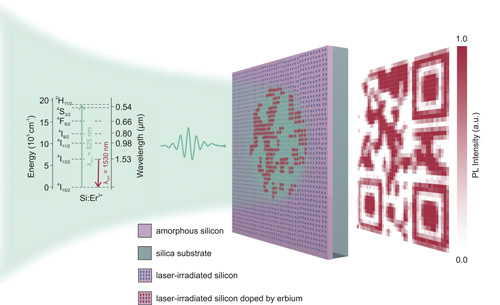| Mar 15, 2021 |
Scientists develop invisible anti-counterfeit labels
(Nanowerk News) Researchers from ITMO University and St. Petersburg Academic University developed a new technology for marking authentic goods. Manufacturers will be able to label electronics, drugs, jewelry, and other products with invisible images that can only be seen with special equipment. These labels will help protect the goods from forgery.
|
|
The research is published in Advanced Materials ("Luminescent Erbium-Doped Silicon Thin Films for Advanced Anti-Counterfeit Labels").
|
 |
| Schematic illustration of the secure label configuration based on the bilayer Er/Si film and its working principle. Selective laser irradiation of the Er/Si double-layered thin film surface (glass/Si (105 nm)/Er (20 nm)) creates luminescent areas due to Er incorporation into the silicon matrix. Then the Er layer is removed by a chemical etching of the sample in HCl solution; besides the silicon layer, erbium-doped silicon areas and silica substrate remain unaffected. Fabrication of non-luminescent spots over the initially recorded pattern makes a solid array of holes indistinguishable in an optical or scanning electron microscope. This array of laser-affected areas is shown as blue spots. However, initially recorded image can be easily seen on the PL map at 1530 nm made under excitation of by a green laser (e.g., 525 nm). Red dots depict the erbium-doped silicon areas demonstrating luminescence under the laser beam. (© Wiley) (click on image to enlarge)
|
|
Companies all over the world are looking for ways to protect their goods from counterfeit. But the available methods offer only temporary solutions. As soon as wrongdoers discover a way to get through the existing protective measures, the technology becomes useless. Russian scientists have proposed new labels that are not so easy to decipher. They are made from semiconductor materials with the help of lasers.
|
|
“With a laser, we add ions of a rare-earth metal called erbium that create a unique image on a sticker made of a silicone nanofilm. To do that, we first make a lattice of holes on the film that are invisible to the naked eye. Some of these holes contain erbium ions, others don’t. When subjected to laser radiation, the holes with erbium change color – and thus they allow us to correctly read the image,” explains Dmitriy Zuev, head of the project, assistant professor at ITMO’s Department of Physics and Engineering.
|
|
It may take wrongdoers a long time to discover the contents of such images. In order to do that, they would have to get into the shipment system, learn to work the equipment, and master label reading methods. These labels are made even more secure due to several customizable characteristics.
|
|
“Our labels are based on erbium ion luminescence, which is characterized by several parameters: intensity, wavelength, and radiative lifetime. A combination of these parameters allows us to create additional layers of protection. That’s why when you get the hidden image with an infrared sensor, you will also be able to read the information about the luminescence parameters. This provides an additional degree of protection,” says Artem Larin, a PhD student at ITMO’s Department of Physics and Engineering.
|
|
The developed system is resistant to chemical and mechanical effects, it also can be made on a flexible film. According to Ivan Mukhin, head of a laboratory at St. Petersburg Academic University and a researcher at ITMO, all of this adds to the technology’s potential to be introduced into the real sector of economy.
|

